
Sough Slog provides peace, inspiration
FLORIDA CITY, Fla.— “I’m sure everyone knows what they’re getting into,” said Everglades Park Ranger Katy Dimos, who would be my tour guide through a freshwater swamp on this sunny South Florida afternoon.
I was a participant in the Sough Slog, one of the many guided tours offered at the Everglades National Park near here. Located just south and west of Miami, the Everglades boasts stretches of sawgrass prairie, expansive swamps and tropical fauna, and it is the only place in the world where alligators and crocodiles cohabitate.
| Click on the video at right to view an audio slide show about an Everglades slough slog photographed and prepared by writer Susan Peavy. |
The Sough Slog travels through the swamp of a cypress dome, promising the sights and sounds of a variety of plants and wildlife.
But here’s the catch: when I say through the swamp, I mean it literally. On the Sough Slog, I waded waist deep through fish, trees and muddy water.
“We’re walking through water, mud, fallen logs, vines and other things under the water that you won’t see,” Dimos warned the group.
| The cypress dome, created by a depression in the limestone floor of the Everglades, resembles a forest within an expansive pond (Photos by Susan Peavy). | 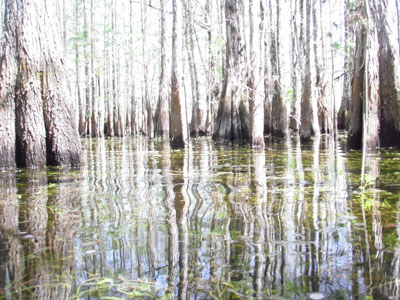 |
The other underwater “things,” I would find out later, were tiny fish which glided around my feet and fish-eating water spiders the size of my hand.
Before setting off into the swamp, however, Dimos filled us in on the Everglades ecology.
“Six thousand to 8,000 years ago, this was a shallow sea. The swamp floor is made of limestone because it is an ancient sea floor,” she told us.
A cypress dome is formed by a depression in the limestone, which causes the trees to grow taller as the floor grows deeper. From the inside the dome resembles a forest within an expansive pond.
The domes, shaped as their name suggests, are visible from the road that cuts through the sea of grass. But what is not visible from the road is the true nature of the cypress domes – the life and spirit that dwells within them and makes the ecosystem function.
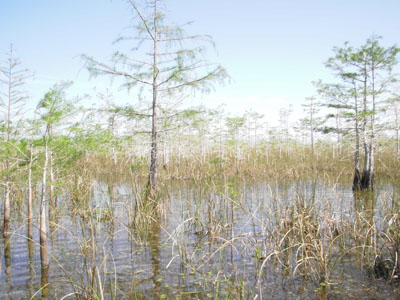 |
On the edges of the cypress dome, the trees grow shorter and the sun brighter. |
“As far as I’m concerned, you haven’t really been to the Everglades until you’ve done something like this,” Dimos told us moments before we set our dry feet into the muddy swamp. Without venturing into the water, “you only get glimpses of what the Everglades really is.”
“Other parks shout for your attention with their beauty,” Dimos continued, “but the Everglades whispers. And today we’re going to hear one of her best whispers.”
The whispering effect of the cypress dome was not the experience I was expecting. Through my pre-slogging homework I knew that we would see an alligator hole, and also that Burmese pythons had recently taken up residence in the Everglades.
“Pythons are unfortunately doing really well out here,” Park Ranger Jamie Cleaver confirmed. “They’re reproducing in the 10s of thousands. The biggest one we’ve caught was 16 feet long.”
With these facts in mind, I was prepared for a somewhat hair-raising trek through the swampy wilderness.
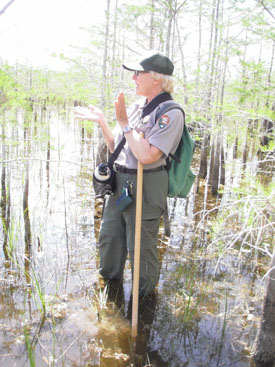 |
Katy Dimos, Everglades Park Ranger and our Sough Slog tour guide, explains the feeding habits of the alligators that live here. |
“But,” Cleaver assured me, “as many times as I’ve done the Sough Slog, I’ve never seen a snake.”
My day would instead be filled with the gentle noises and peaceful sensations of the cypress dome.
As my feet felt tentatively through the murk and mud, my eyes took in the sea of cypress trees and the tropical plants and flowers that grow amongst them. And as Dimos passed around various plants, the aroma of pine and other vegetation stimulated my nose.
“I always notice the wind,” Dimos told us. “It makes a different noise depending on what it’s moving through. I like to imagine where it was before I heard it, and where it’s going next.”
Dimos, with her careful appreciation for and knowledge of plant and wildlife, added an almost spiritual element to the already peaceful trail.
“She was very informative,” said Patty, from Miami, of Dimos. “It was a fun family adventure.” Patty came to the Everglades to Slog with her husband and two sons.
“It was cool!” The younger son, Tyler, exclaimed at the end of the tour. After a moment’s thought he added, “It was wet.” Tyler seemed particularly excited about the hands-on element of the tour as he stomped enthusiastically through the mud.
| A group of Sloggers wade ankle-deep in the freshwater swamp of the cypress dome. | 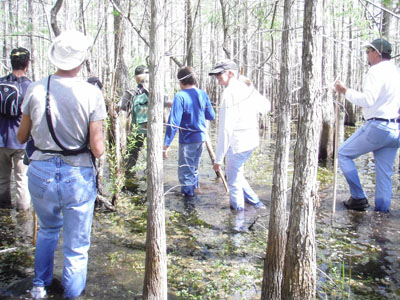 |
Dimos encouraged the group to experience not only the sensation of the calming breezes and the sound of calling birds as we stood in the still water, but also to learn about the plants and animals who live there.
“The Everglades is the only place that was made for its biodiversity, which is unmatched anywhere in the world, and not for its scenery,” Dimos explained.
Throughout the tour, Dimos showed us plants that eat insects, vines that strangle trees and flowers of pink, purple and yellow. And, as promised, she also stopped us at the edge of an alligator hole.
“We saw two alligators here the other day,” Dimos told us at this point. “It was really exciting. But they won’t bother us if we don’t bother them, and we certainly won’t be bothering them.”
“We call them the keepers of the everglades,” she explained further. “They make depressions in the floor of the swamp, and when the dry season comes the water remains there, so the fish go there and the birds go there to eat.
“The alligators have their pick of food, but it also helps the other animals to survive by giving them a place to live in the dry season.”
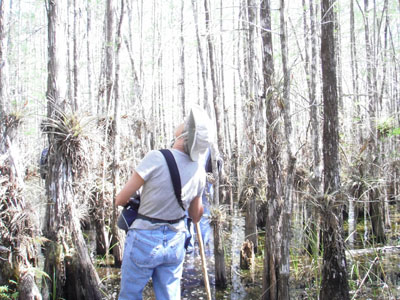 |
Hearing the chirp of a red shouldered hawk, Karen Gallagher searches the treetops for a glimpse. |
Dimos ended the tour by asking us frankly, “so what?” In other words, aside from our pleasant afternoon walk why is the Everglades so important?
For one thing, in South Florida we get water and clean air from the Everglades. It’s also a major migratory path for birds.
But on a more personal level, Dimos pointed out that “our spirits need wild places. Artists come here and are inspired. For me, something happens to me every time I come out here.”
On the drive home from the Everglades that Saturday, I took more with me than just the mud on my shoes. Dimos’ reverence for the wilderness of the Everglades rubbed off on me as well. The Sough Slog ended up soothing my soul.
If You Go:
- The Sough Slog is run out of the Ernest Coe Visitor Center, located at 40001 State Road 9336, Homestead, Fla. 33034. Directions (from U.S. 1 South): Turn right onto Palm Drive (State Road 9336 / SW 344th Street) and follow signs to the park. Hours of operation: 9 a.m. to 5 p.m. Phone: 305-242-7700 (ask for visitor center).
- Reservations are required to participate, and participants must be 12 years of age or older.
- Participants must wear sturdy, lace-up shoes and long pants.
- Wear sunscreen and bring water.
- The tour is only available during the winter.

Comments are Closed